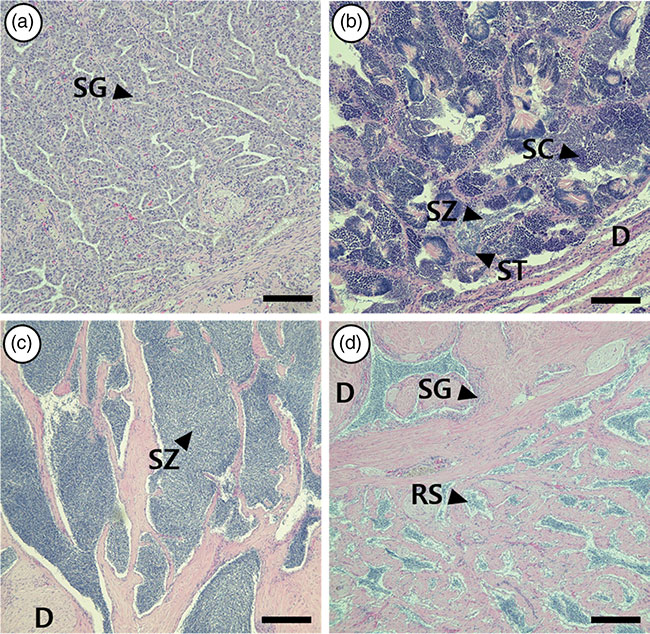
News & Views
Fish Health
Research
South Korean research explores reproductive cycle of farmed Pacific blue tuna
February 13, 2024 By Ruby Gonzalez
 Histological sections of PBT testes at different stages of gonadal development. The testes stages are as follows: (a) resting; (b) maturing (spermatogenic); (c) spawning capable; (d) post-spawning.
Photo: journal of World Aquaculture Society
Histological sections of PBT testes at different stages of gonadal development. The testes stages are as follows: (a) resting; (b) maturing (spermatogenic); (c) spawning capable; (d) post-spawning.
Photo: journal of World Aquaculture Society The reproductive potential of farmed Pacific bluefin tuna (PBT, Thunnus orientalis) was confirmed in a study in South Korea, contributing to the sustainability of this industry.
Identifying the spawning period in a culture environment, the research team, Jin Woo Park et al., said mature gonads capable of spawning occurred mostly from July to August.
The study, “The reproductive potential of Pacific bluefin tuna farmed in sea cages in South Korea,” was published in the Journal of the World Aquaculture Society.
It investigated farmed wild-caught PBT and their development into mature individuals, paving the phase for the rearing of reproductively mature individuals. PBT farming in South Korea is dependent on wild-caught juveniles, which are grown to harvest-size.
“Currently, in South Korea, private companies are conducting the technical groundwork for PBT farming in sea cages, and preliminary research on their reproductive physiology has further progressed to ensure the availability of PBT that reach the reproductive age (five to six years).
“This study was conducted to identify the reproductive cycle of PBT reared in sea cages in South Korea and explore the possibility of spawning in this environment to advance our knowledge of PBT farming. To the best of our knowledge, this is the first study to investigate the reproductive potential of PBT in South Korea,” authors said.
They stressed the importance of identifying environmental effects on the reproduction cycle and sex hormones for ensuring sustainable productivity in farming the species.
Between June to August, which represented the potential reproduction periods, the water temperature varied from 22-24 C. The photoperiod was 14 hours light to 10 hours darkness.
“Overall, this study provides useful insights into PBT farming in South Korea and is the first to investigate the reproductive biology of PBT,” they said.
“However, the environment surrounding sea cages varies on an annual basis, thus continuous research on environmental and maturity changes is required to establish the reproductive characteristics in the sea cages, which may be useful to manage the broodstock for sustainable PBT aquaculture.”
Print this page
Advertisement
- GenoMar appoints new fish health & quality group manager
- Ugandan agency develops herbal fish medicine





